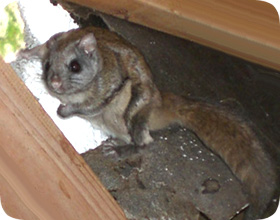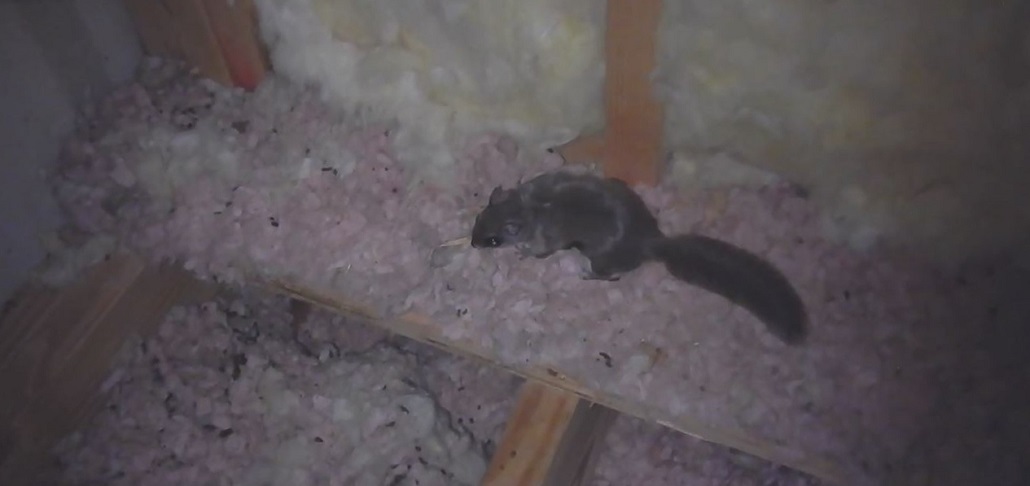- USA Wildlife Removal Education Guide and Resources
Flying Squirrel Removal

Flying squirrels are the gliding cousins of the common eastern gray squirrel. The flying squirrel population is growing and more and more people are finding them to be quite a nuisance. Flying squirrels are very small, have large eyes and a special flap of skin that extends from their wrists to their ankles that gives them the ability to glide. However, flying squirrels are a misnomer because they cannot fly in the traditional sense, but instead they can glide from tree to tree or from branch to your roof. While flying squirrels are cute and different from other squirrel species, you will soon find that they are not enjoyable to have around if you should be unlucky enough to get invaded by them.

Taking away a flying squirrel’s food supply is probably the best way to get rid of them. If they cannot eat, then they cannot stick around. You can ensure that they are not building up their food caches by putting up a nice sturdy fence around your garden. This is not a guarantee that they will not get to it because they can glide, but it helps. Another thing that you can do is to make sure that any fallen fruit, vegetables or nuts are picked up off the ground. Make sure that your pets’ food is also brought inside, and not left outside.
If the flying squirrels have not yet invaded your home the easiest way to ensure that they do not find their way into your home is to trim all the tree branches around your home so that they cannot glide onto your roof. Another thing that you can do is to patch up any holes that may be on the exterior of your home as well as secure any vents that you may have. Chimneys are another entry point for flying squirrels, but putting a chimney cap on it should fix that problem.
If these critters have already found their way into your home you will need to trap them. However, make sure that it is legal to trap flying squirrels in your area as you do not want to break the law and risk a fine. Set the traps near the entry points that they are using and up in your attic. Bait the trap with something good like cheese or peanut butter and then check the traps everyday to see if you have caught any. Once you have trapped the squirrels you will want to relocate them at least 20 miles away from your home and then patch up all the entry points that they were using. Check your patches every so often to make sure that they have not returned.
Go back to the main Squirrel Removal page for more information about flying squirrel removal.
Learn more about How to Kill Flying Squirrels.
Learn some additional tips on my How To Get Rid of Flying Squirrels Yourself page - more flying squirrel removal tips and methods.
Learn all About Flying Squirrel and How to Get Rid of Flying Squirrels. Learn how to detect if you have Flying Squirrels in Your Attic and how to Trap or Exclude Flying Squirrels. Learn why flying squirrels Chew on Electrical Cables and how to Kill Flying Squirrels. I can show you How to Get a Flying Squirrel from Your Attic and everything you need to know about Flying Squirrel Prevention. I can answer if a Flying Squirrel Can Actually Fly and if repellents will get Flying Squirrels out of the Attic.
Flying squirrels as pets - they have become very popular amongst outdoor enthusiasts and pet owners. The cute appearance of the flying squirrel and the minimal amount of maintenance required appeals to exotic animal owners, and naturists enjoy watching the rodents in their natural environments.
Flying Squirrel Information
Biology
Flying squirrels are nocturnal. They use the position of their arms and legs to help them change direction and speed as they glide from tree to tree. The fluffy tail helps to stabilize them in the air and acts as a type of brake before they land. While flying squirrels cannot actually fly like birds, they do glide from tree to tree which gives the appearance of flight.
There are two types of flying squirrels: the Northern flying squirrel and the Southern flying squirrel. Size, color, diet and nesting habits are varied between the two. Northern flying squirrels typically have a body that is 8 inches long with an additional 6 inches in length from the tail. Southern flying squirrels are smaller and slightly more aggressive. The Northern species are often described as not being as pretty as the Southern species, but their tails are much thicker. Both species are able to glide due the loose skin that connects the front legs to the back legs.
Habitat
Flying squirrels make their homes in North American deciduous forests. Nests are built in the cavities of trees, and some flying squirrels will inhabit cavities in which other animals previously nested. The nests are often composed of natural plant materials such as bark, moss, grass, leaves and twigs. Some nests will also contain feathers and furs that the flying squirrels have found during their foraging. There have even been nests found that used man-made materials, such as newspapers and attic insulation.
The diet of the flying squirrel can be varied depending on what is available to eat. They prefer to feast on nuts, seeds, bark, flowers and roots. They will even eat insects, spiders, eggs and small animals if foraging becomes difficult. Flying squirrels use their excellent hearing and sense of smell to sense predators. They are hunted by foxes, coyotes, hawks, weasels and owls. A flying squirrel will look for food within a close distance to a tree so that it may jump to safety if necessary.
Life Cycle
Flying squirrels live for approximately five years in the wild. The mating season occurs between February and March. Babies are born in special natal nests, which are larger and deeper than the nests that they will build when they are adults. Newborn flying squirrels are blind and hairless. Once they are about five weeks old, they will have developed fur and teeth. By the time they are three months old, flying squirrels have gained the knowledge and skills they need to be independent.
Diseases Flying Squirrels Carry
Flying squirrels carry lice, fleas, tapeworms and other parasites. They are rarely infected with rabies, but a few cases of rabid flying squirrels have been documented. Flying squirrels can transfer only one known disease, typhus, to humans. It is spread through the feces of infected lice. Typhus can be effectively treated using tetracycline therapy, although this is not recommended for pregnant women or those with weakened immune systems. Typhus symptoms include headache, aching muscles, fever, chills and nausea. A red rash may also be present on the skin. If left untreated, typhus can become more severe and lead to vomiting, meningitis, encephalitis and pneumonia. A lab test will determine whether or not typhus is the cause.
Problems Flying Squirrels Pose to Humans
Flying squirrels do not pose severe problems to humans, although they will build bothersome nests in home attics. Their droppings and messes they leave behind may cause problems both sanitary and health-wise. They can damage the floors, attics and walls of the home as they build their nests and search for foods. They do not frequently bite unless they think a hand smells like food or if they feel threatened.
How to Remove Flying Squirrels in the House or Roof
Homes with no mentionable attic space sometimes succumb to infestation of flying squirrels inside the actual roof itself. This is because the air and insulation pocket between the interior and the exterior roof makes a perfect place for a small animal such as a squirrel to nest. This scenario can be particularly hard to deal with due to the awkward locations the squirrels use to enter the building. Because you have no way to crawl inside the roof space, your only option to remove these flying squirrels is to use the exclusion, one-way door trap. Determine where the squirrels are entering the roof and install the traps. Be very careful not to leave any openings unprotected or you will continue to have issues. In this situation, professional guidance is recommended. Not only are traps difficult to install on high roofs, any infant squirrels must be located and removed. If you fail to do this, the baby squirrels will likely perish and emit an unpleasant, lingering odor throughout the home. Baby squirrels in this type of roof can be extremely difficult to locate and remove. If you trap and relocate the squirrels on your own and notice a smell a few weeks later, you will need to find and remove the dead babies or the smell will not go away.

